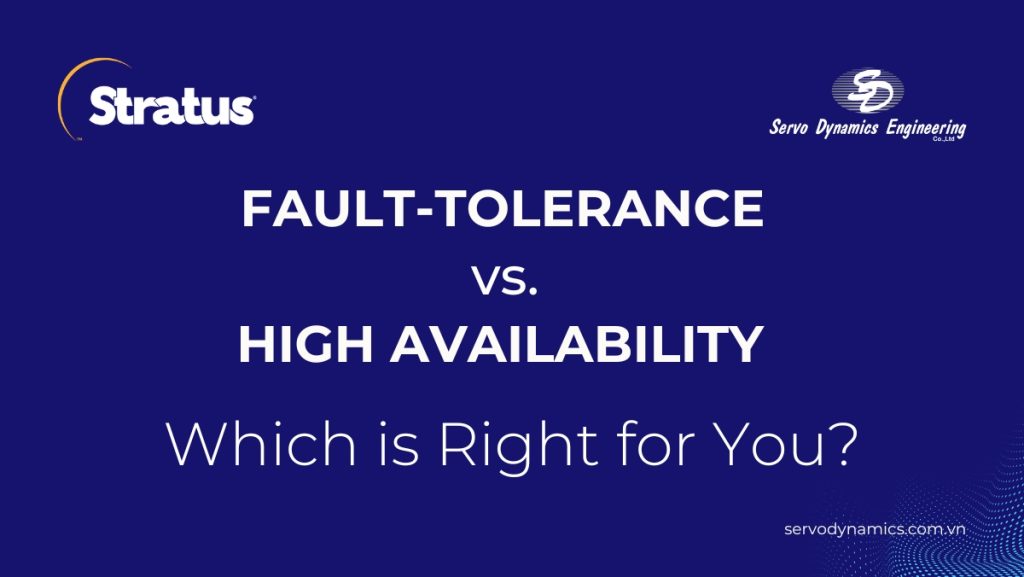Solutions, News, Stratus Technologies
High-Availability versus Fault-Tolerant: Understanding the Key Differences
Modern systems demand uninterrupted operation to meet user expectations and business requirements. However, achieving this reliability involves understanding two critical concepts: high availability and fault tolerance. Though often used interchangeably, these terms refer to distinct strategies for minimizing downtime and ensuring system resilience. This article explores these concepts, their characteristics, examples, differences, and how to choose the right one for your needs.
What is High Availability?
High availability (HA) refers to a system’s ability to remain operational and accessible for a significant majority of the time, typically measured by uptime percentages (e.g., 99.9%, 99.99%, or “five nines” at 99.999%). The goal of high availability is to minimize downtime and ensure that users can rely on the system to function almost continuously.
Key Characteristics of High Availability:
- Redundancy: High-availability systems often have redundant components (e.g., multiple servers, networks, or databases) to ensure that if one fails, others can take over.
- Failover Mechanisms: When a component fails, the system automatically switches to a backup or redundant system with minimal disruption.
- Load Balancing: Traffic is distributed across multiple resources to prevent any single component from becoming a bottleneck or failing due to overload.
- Planned Maintenance: Systems are designed to perform maintenance activities without taking the entire system offline.
Examples:
- A cloud-based application using multiple data centers to ensure users can access services even if one data center goes offline.
- A load-balanced web server cluster where traffic is automatically routed to healthy servers.
High availability is about reducing the likelihood of downtime and quickly recovering from failures. However, it doesn’t guarantee that failures won’t occur.
What is Fault Tolerance?
Fault tolerance, on the other hand, is the ability of a system to continue operating seamlessly and without interruption, even in the presence of hardware or software failures. Fault-tolerant systems are designed to prevent failures from affecting end-users entirely, often achieving zero downtime.
Key Characteristics of Fault Tolerance:
- Complete Redundancy: Every component in the system (hardware, software, or network) is duplicated, often in real-time. Both primary and backup components operate in parallel.
- Error Detection and Correction: Fault-tolerant systems can detect errors and self-correct without external intervention.
- No Single Point of Failure: The architecture is designed so that failure in any single component doesn’t impact the overall system’s functionality.
- Higher Costs: Achieving fault tolerance requires significant investment in resources, as complete duplication of components and real-time synchronization are required.
Examples:
- An aircraft’s avionics system where multiple redundant systems operate in parallel to ensure uninterrupted operation, even if one system fails.
- Financial transaction systems that must continue to process payments without interruption, even if hardware components fail.
Fault tolerance is about ensuring uninterrupted operation, regardless of failures. This makes it a more robust but costlier approach than high availability.
Key Differences Between High Availability and Fault Tolerance

| Aspect | High Availability | Fault Tolerance |
| Definition | Aims to minimize downtime and quickly recover from failures. | Ensures seamless operation with zero downtime, even during failures. |
| Redundancy | Partial redundancy (standby systems activated during failure). | Full redundancy (all components active simultaneously). |
| Downtime | May experience brief downtime during failover. | No downtime, failures are invisible to users. |
| Cost | Generally less expensive due to partial redundancy. | Significantly more expensive due to full redundancy and complexity. |
| Complexity | Moderate; requires failover and monitoring mechanisms. | High; requires real-time synchronization and duplication. |
| Best Use Cases | Applications where minimal downtime is acceptable (e.g., e-commerce, SaaS platforms). | Mission-critical systems where downtime is unacceptable (e.g., healthcare, aviation). |
Choosing Between High Availability and Fault Tolerance
When deciding between high availability and fault tolerance, consider the following factors:
- System Criticality: For mission-critical systems, fault tolerance is often necessary. For less critical applications, high availability may suffice.
- Budget Constraints: Fault-tolerant systems are more expensive. High availability offers a more cost-effective solution.
- Downtime Tolerance: Assess how much downtime your system can handle. High availability is suitable for systems that can endure minimal interruptions, while fault tolerance is ideal for those requiring seamless operations.
- Complexity and Maintenance: Fault-tolerant systems are more complex to design and maintain. Choose high availability for simpler implementation and management.
Stratus Solutions for High Availability and Fault Tolerance
Stratus Technologies is a leader in providing high-availability and fault-tolerant solutions, particularly designed for industries where continuous uptime is critical. Stratus’ EverRun and ztC solutions offer a blend of high availability and fault tolerance by ensuring that systems can keep running even during hardware failures, without the need for complex IT interventions.
- EverRun provides a software-based fault tolerance solution that protects against downtime caused by server failures. It uses parallel processing to ensure that if one server fails, another takes over without interruption to the end user.
- Stratus ztC Edge delivers a fault-tolerant solution that requires no manual intervention and automatically recovers from hardware failures, making it ideal for remote or unmanned installations that still require continuous operation.
These solutions are perfect for industries such as manufacturing, energy, and transportation, where downtime is costly and even a few seconds of interruption can lead to significant losses.

 Tiếng Việt
Tiếng Việt



